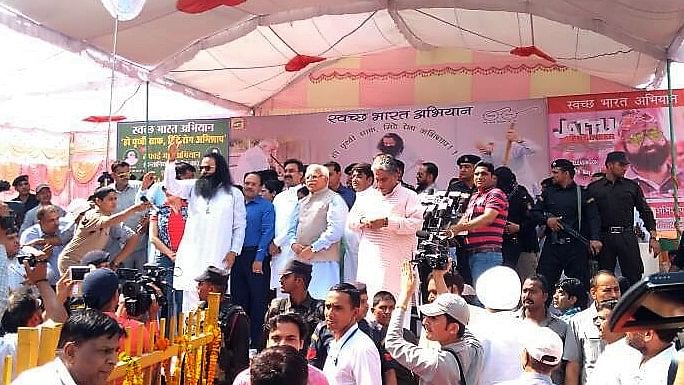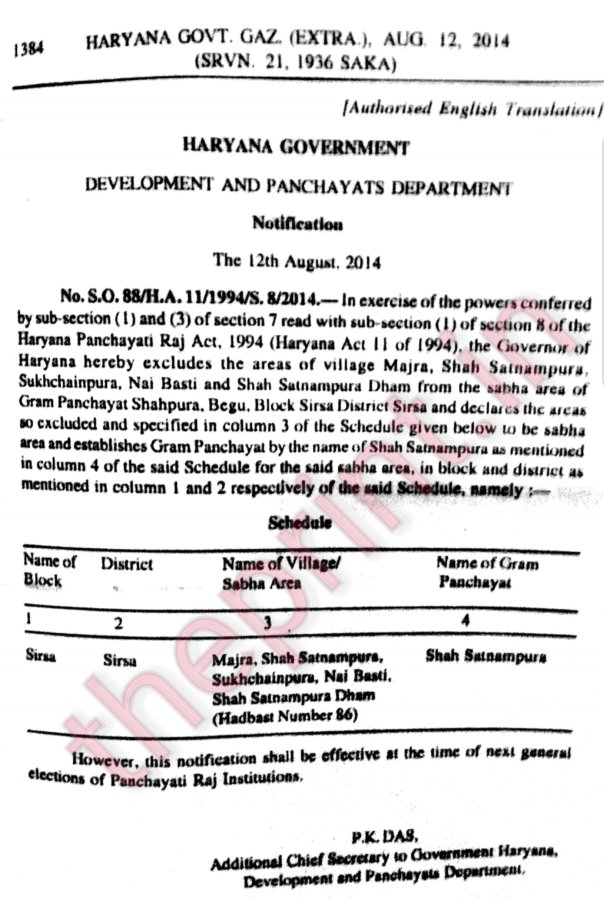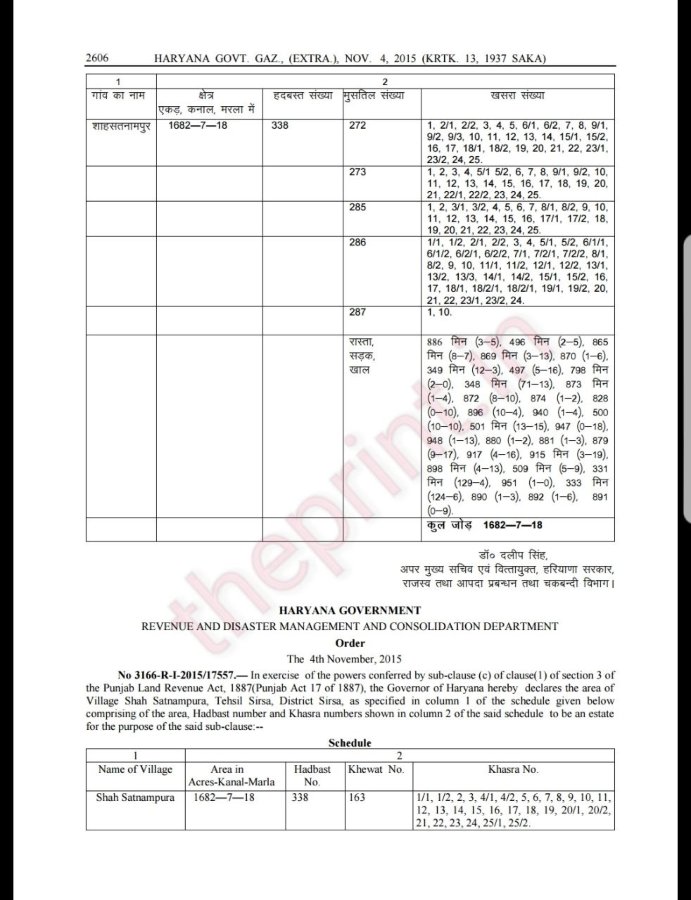Haryana government carved out a new revenue estate and exempted 11 of Ram Rahim’s Dera Sacha Sauda properties from ‘change of land use’ approvals.
The controversial Dera Sacha Sauda of Gurmeet Ram Rahim Singh has generally been on the right side of the Haryana government – irrespective of the party in power. And the state government has been more than generous to the dera, going out of its way, if necessary, to dole out favours.
In one such glaring case, the Haryana government went to the extent of carving out a new revenue estate — village Shah Satnam Pura — on the outskirts of Sirsa, where the dera is headquartered. The result: a host of unauthorised dera constructions were regularised overnight.
The seeds of the process were sown during the Congress rule of Bhupinder Singh Hooda in 2014 and gained traction under the BJP government of Manohar Lal Khattar. The dera had asked its followers to support the BJP in the 2014 Haryana Assembly elections.
Documents accessed by ThePrint show that as many as 11 structures/construction sites of the dera were exempted from the requirement of a ‘change of land use’ (CLU). These exemptions were given within a month of the new revenue estate coming into existence.
The move not only deprived the state exchequer of revenue it could have generated from issuing the CLU approvals and levying external development charges, it also raised questions over the manner in which illegal structures were regularised.
Repeated attempts by ThePrint to get top government officials such as financial commissioner revenue, Keshni Anand Arora, and deputy commissioner (Sirsa), Prabhjot Singh, to comment were unsuccessful.
Chief Minister Khattar too did not respond to questions sent to him through his media advisor Amit Arya.
State revenue minister Capt. Abhimanyu said he was travelling and would look into the allegations on his return.
Initial steps towards regularisation
The dera has two complexes in Sirsa. The old dera complex falls within the municipal limits of Sirsa town, while the new one is almost 7 km from town on the Sirsa-Bhadra Road, and is spread over 700 acres of land.
When the dera started buying land outside the town for the new complex, it was under the revenue estate of village Shahpur Begu (Tehsil Sirsa), and later, as it spread further, the land of adjoining village Najia Khera (Tehsil Nathusari Chopta) started getting used up.
The dera continued construction work on its land spread across these two villages.
Apart from the dera chief’s palatial residence, as well as for his family members, this complex houses a cinema hall, a hospital, a resort, a school, an exhibition ground, a prayer shed, an organic farm, a stadium, a residential complex, offices of the dera’s publications and a trading company.
While most of the dera’s constructions in village Najia Khera did not require any approval as these did not come under the “controlled area” — a zone under the control of the town and country planning department — a majority of the constructions in Shahpur Begu village fell within the “controlled area” and required government permissions.
In August 2014 – when Hooda was CM – Shah Satnam Pura panchayat was created by splitting the panchayat of Shahpur Begu. “This was an administrative move done for the purpose of better governance of the two villages. The resolution for the bifurcation had been moved by the gram sabha and the gram panchayat of Shahpur Begu,” said R.K. Mehta, deputy director, department of rural development and panchayats, Haryana.
Below is the notification issued by the panchayat department:
However, the revenue estate or the physical area of the new village was demarcated only on 4 November 2015 – by the BJP government of Khattar – when the department of revenue issued a notification carving out 1,682 acres for Shah Satnam Pura.
Below is the notification issued by the revenue department:
Permissions sought and granted
The demarcation followed applications for CLU permissions by units of the dera from early to mid-2015 to the department of town and country planning.
Within days of the notification of the creation of the revenue estate the deputy commissioner of Sirsa issued a map (number 6005 dated 27.11.2015) of the newly-carved revenue estate, delineating the areas which fell within the ‘abadi deh’ – the core area in a village where houses are located. This area is enclosed by the ‘lal dora’ or the red line on the village map.
Structures located within the ‘abadi deh’ or ‘lal dora’ do not require permission for change of land use and are not bound by any building bylaw. Construction within this zone can be done freely. The ‘abadi deh’ areas proposed by the DC included most of the structures/construction sites of the dera.
Below are copies of the district collector’s order and his map:
On the basis of the DC’s revenue plan, the town and country planning department granted 11 dera constructions exemption from CLU through an order dated 31 December 2015.
Below is a copy of the order exempting CLU permissions:
The sites included over 100 acres of dera buildings, including a hostel, a farm house, sheds, the stadium, the cinema hall, the industrial unit, a dharamshala, among others.
District town planner Karamveer Singh said once the revenue plan and map was received from the DC, the rest of the process fell within the purview of rules.
“The rules are clear. CLU cannot be levied on sites that are within the ‘abadi deh’ of a village. We exempted the sites (of the dera) after we received the revenue plan from the DC,” Singh said.






This news is incomplete. Its not just about CLU. There is something big which you have missed in it.